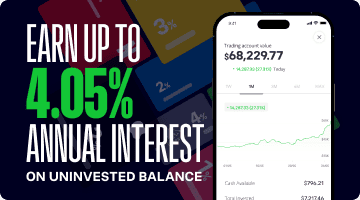- Rheinmetall is riding a surge in European defense spending and geopolitical tensions
- With many upside catalysts now being priced in, the valuation raises questions
- We break down fundamentals, risks, and upside potential. Does Rheinmetall still belong on your radar?
“Elevator Pitch” Overview
Rheinmetall is Europe’s go-to supplier for NATO-standard defense gear—delivering everything from ammunition to armored vehicles. As Germany’s leading arms manufacturer, it’s been a major beneficiary of rising defense budgets and the continent’s renewed focus on military readiness. Since the start of the war in Ukraine, Rheinmetall’s sales have multiplied several times over, riding the wave of this structural shift in European defense policy.
What Does The Company Actually Do?
Rheinmetall manufactures a wide range of ammunition, shells, ground vehicles, air defense systems, and technological warfare systems. It is a leading force in modernizing Europe’s defense industry to catch up with modern warfare tactics such as electronic attacks, drones, and others.

The company operates across four business units. Most of its sales come from Vehicle Systems at 41,3%, followed by Weapons and Ammunition at 26%. The remaining sales are split between Power Systems and Electronic Solutions. The first two segments are driving margin improvement and growth, while the company has been scaling back the latter slightly. For a deeper dive into the segments, check out my previous article about Rheinmetall.
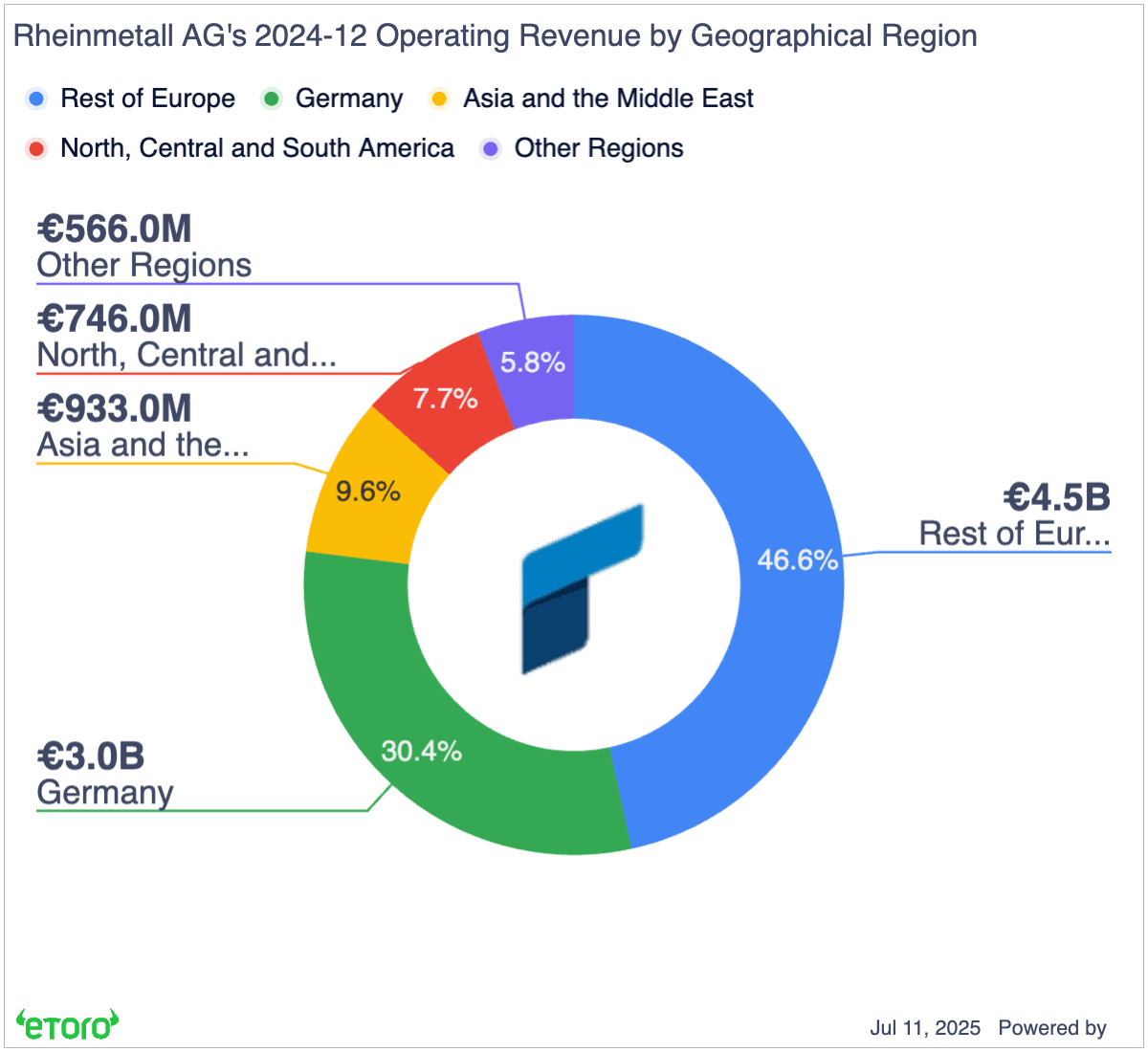
Unsurprisingly, Germany is Rheinmetall’s largest customer, accounting for 30.4% of 2024 sales. But the company’s reach extends well beyond its home country. Nearly half of its sales come from other NATO allies across Europe.
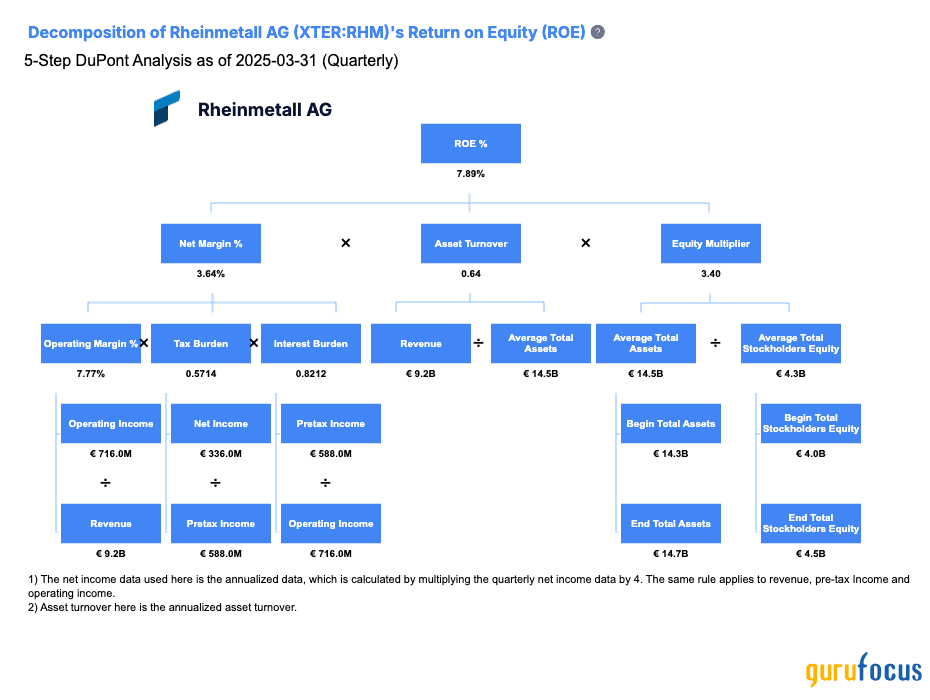
It’s worth noting that arms manufacturing is a capital-intensive business with traditionally low single-digit net margins. That means scaling production isn’t easy without strong visibility on future revenues—reflected in Rheinmetall’s relatively modest operating and net margins.
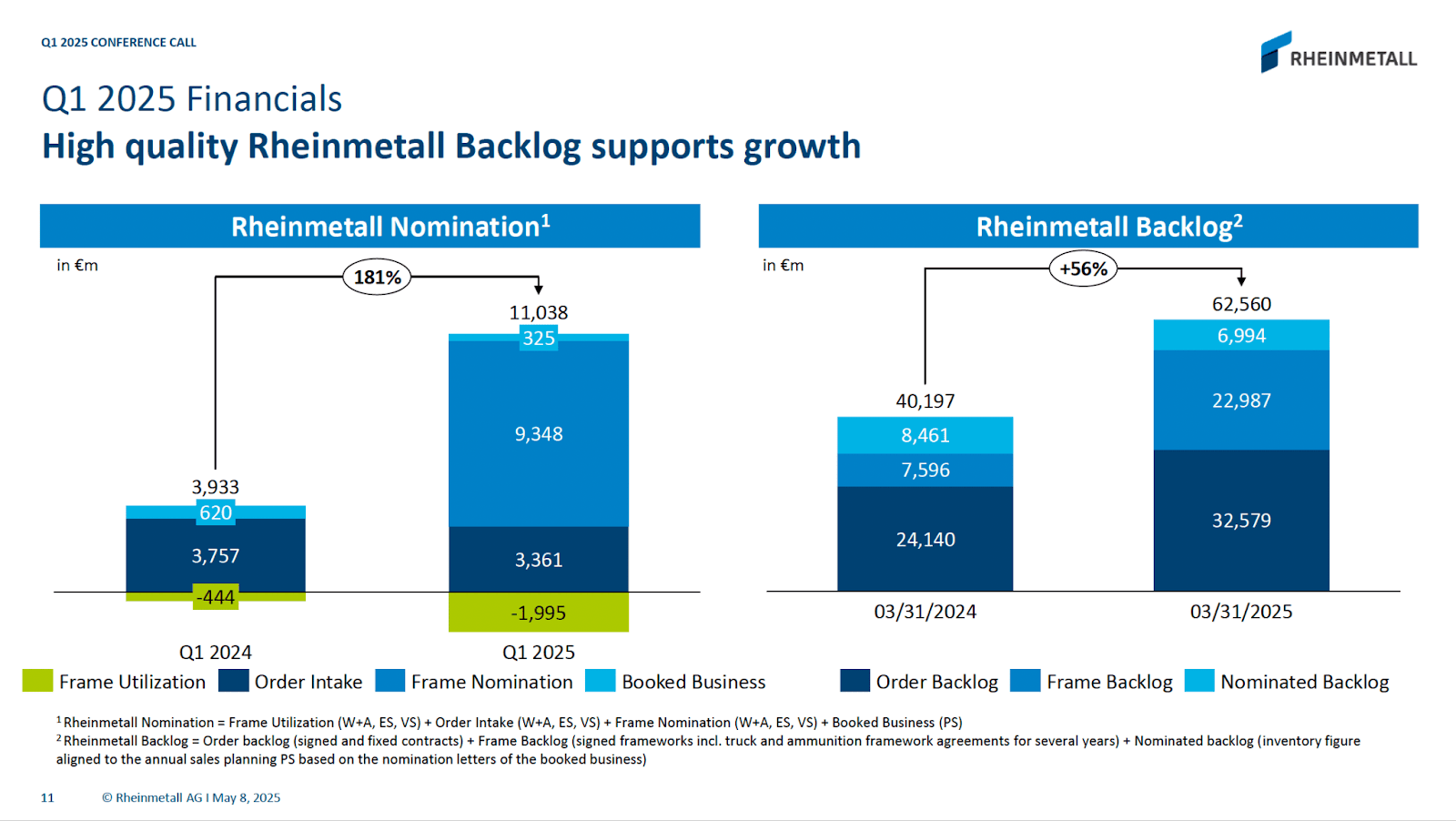
Many of Rheinmetall’s contracts are long-term in nature, often structured as framework agreements—essentially, open-ended deals that can be drawn upon over time. Think of it as: “We may purchase up to €1 billion worth of ammunition from you over the next five years.”
For Rheinmetall, a key metric to watch is the order backlog—the total value of signed contracts. At the moment, this stands at more than six times the company’s 2024 sales, with over half already confirmed as actual orders. Going forward, the biggest challenge to growth won’t be demand, but manufacturing capacity.
Why Should Investors Watch Out Now?
Rising NATO budgets has powered the industry’s growth over the past few years. The conflict in Ukraine served as a wake-up call for European governments, prompting a surge in military spending. On top of that, Donald Trump’s pressure on NATO allies to increase their defense spending further fueled the rally—Rheinmetall shares have climbed over 230% since his election.
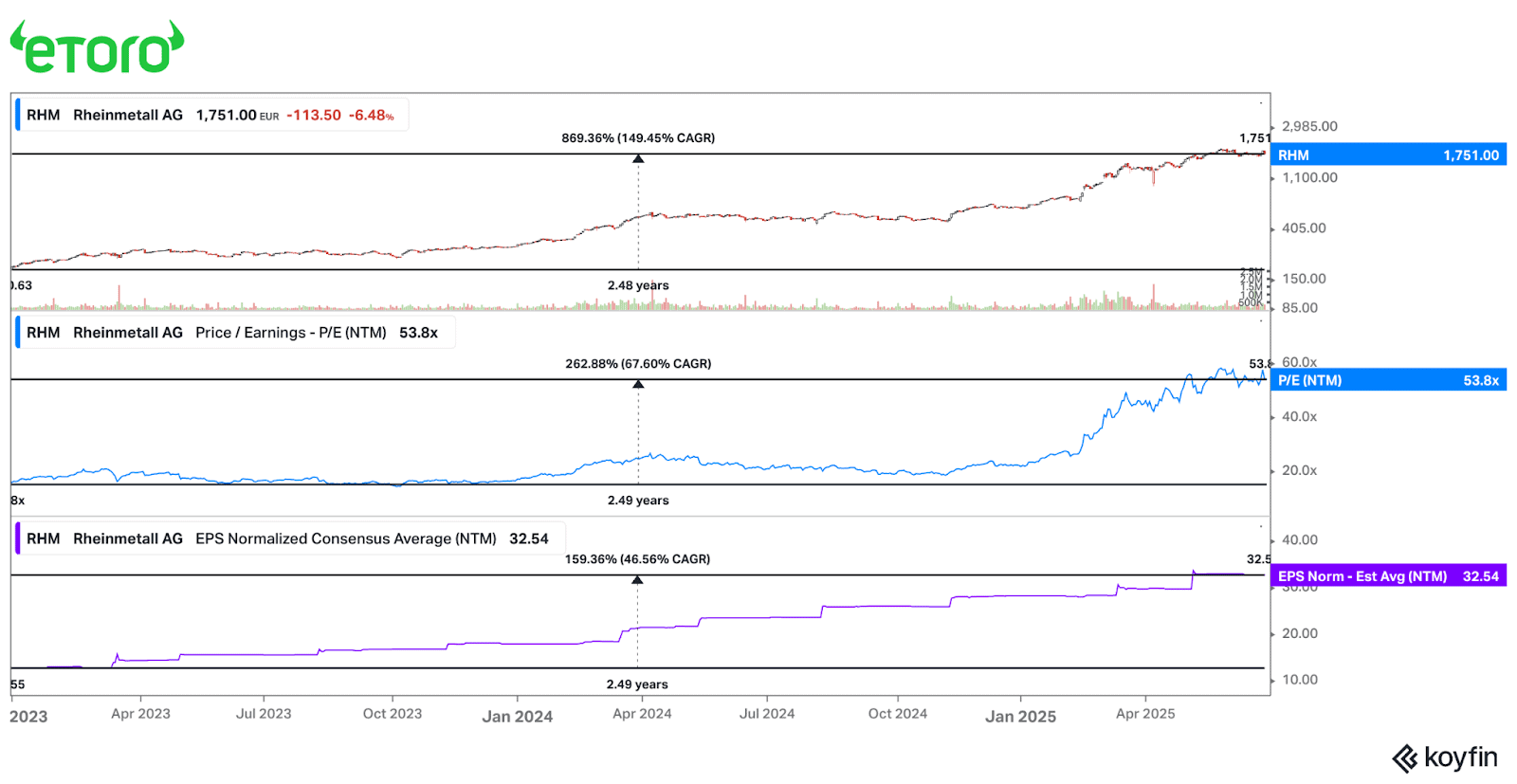
But when we break down that growth, a different picture emerges: while the business has expanded, a significant portion of the stock’s gains comes from multiple expansion, not just earnings growth. That’s a red flag. It suggests the market has moved ahead of fundamentals, pricing in high expectations the company hasn’t yet delivered on.
While rising investor sentiment has driven multiples higher, not much has changed to make the company’s earnings that much more valuable. Margins are growing, but slowly. New factories in Germany, Latvia, and Hungary are in the works, and Rheinmetall has been active on the M&A front, such as its acquisition of Loc Performance in the U.S. and several joint ventures.
While these steps are strategically sound and support rising returns on invested capital, they don’t dramatically change the growth trajectory. Factories take years to complete, and the way I see it, more and more expectations are being baked in with little positive catalysts in the near future to support them.
Some of the margin boost comes from a more favorable product mix—Rheinmetall is shifting from lower-margin automotive components to higher-margin munitions and armored vehicles. The company also benefits from increased pricing power due to the urgent need to replenish ammunition stockpiles. However, these are cyclical tailwinds, not structural shifts. Once inventories are rebuilt and demand normalizes, pricing power and volume-driven efficiencies may taper off.
Looking ahead, further upside looks limited:
- NATO budgets have largely been set and are unlikely to rise meaningfully from here.
- Trump has softened his rhetoric around NATO and supported a joint statement reaffirming Article 5.
- EU-level defense funding has been agreed upon—but additional increases are unlikely in the near term.
Unless the conflict in Ukraine escalates further, there’s little to justify further upside. On the contrary, risks are piling up:
- Budget constraints could slow planned military spending.
- Political fragmentation—such as Spain’s recent opposition to increased NATO funding—may create headwinds.
- Capacity expansion could face rising costs or longer lead times than expected.
- And any sign of de-escalation in Ukraine could trigger a sharp reversal in sentiment, especially given Rheinmetall’s popularity among retail investors.
In short, Rheinmetall’s fundamentals remain strong, but with the stock priced for perfection, the risk/reward balance is tilting the wrong way. Upside looks capped, while downside risks—both geopolitical and operational—are becoming harder to ignore.
Financial Health Check
Financial health is a bit like insurance—you barely think about it when things are going well, but you’ll wish you had it when trouble hits. Fortunately, Rheinmetall doesn’t have to worry. The company is in a strong financial position, backed by an investment-grade credit rating and solid cash flows.
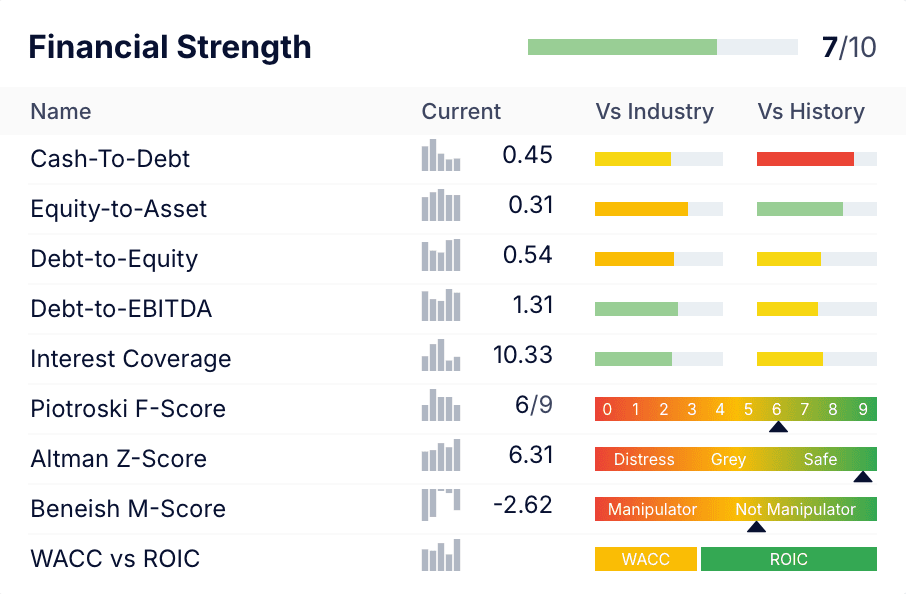
The equity to asset ratio currently sits at 0,31, reflecting a relatively high level of leverage that has increased over the past two years. However, Rheinmetall’s strong interest coverage and healthy cash generation suggest that the debt load remains manageable.
With a debt-to-EBITDA ratio of 1.31, the company appears to be using its financial position strategically—leveraging its growth to fund further expansion without tipping into overleveraged territory.
Still, as leverage rises, it’s important for investors to keep an eye on the balance sheet. Any signs of weakening cash flow or difficulty meeting obligations could shift the story quickly.
Moat Analysis
The moat, or competitive advantage, is the key to sustained compounding over the long term.
Rheinmetall’s moat is solid but not impenetrable. It rests primarily on its strategic geographic location and government relationships. But the company still faces stiff competition outside its home market. Its technological edge, particularly in vehicle and air defense systems, adds an important layer of protection.
| Moat pillar | Breakdown |
| Regulatory advantage | Government defense contracts are highly regulated and require extensive lobbying, long approval cycles, and established relationships. Rheinmetall’s deep ties with the German government give it a clear edge in securing domestic contracts. |
| Capital-intensity advantage | Building defense manufacturing facilities requires massive upfront investment and long lead times. While this deters new entrants, Rheinmetall still faces stiff competition from other established European defense companies. |
| Geographic advantage | European allies will spend more on defense, but are looking to keep the majority of investments within their borders. As a German company, Rheinmetall will benefit from one of the largest budgets in the region. |
| Technological advantage | As modern warfare shifts towards electronic and cyber capabilities, Rheinmetall’s investments in vehicle automation and battlefield tech (like air defense and electronic warfare systems) keep it ahead of the curve. |
Rheinmetall has a solid, but not impenetrable moat. Its location within Germany provides a strong home-field advantage, especially as defense spending becomes more localized.
Industry & Competitive Landscape
The defense industry is highly competitive and fragmented, which limits pricing power for most players. That said, Rheinmetall has carved out a strong position—particularly in advanced weapons systems and military vehicles—giving it a clear edge in several key segments.
Here’s a quick look at some of its main competitors:
- BAE Systems (UK) – A key rival in vehicles and artillery
- Leonardo (Italy) – Strong in electronics and land combat systems
- Thales (France) – Specializes in sensors and battlefield electronics
- Saab (Sweden) – Competes in rockets, sensors, and ammunition
- Rolls-Royce – Focused on propulsion systems
- Various smaller ammunition manufacturers compete at lower scale and price points
US defense contractors remain highly competitive globally, but they face increasing pressure due to the deteriorating relationship between the USA and the EU, so I’m not listing them.
Currently, geography plays a critical role. NATO allies are ramping up defense spending, aiming for 5% of GDP by 2035. With Germany being Europe’s largest economy, this translates into hundreds of billions in new investments, and Rheinmetall is well-positioned to be a primary beneficiary.
Moreover, Rheinmetall’s ability to supply NATO-standard equipment gives it an advantage across allied countries.
Capital return to shareholders
Rheinmetall is now in aggressive growth mode. Therefore, it pays a tiny dividend of 0,41% and isn’t buying back its stock nor paying down debt. This capital allocation strategy makes a lot of sense for the current stage of the industry cycle.
Valuation & Street View
The stock is not cheap by any means. After more than tripling in the wake of the Ukraine conflict, shares have surged another 230%+ since Donald Trump’s election victory. Even when comparing to the already high multiples from 2022, the stock is now trading at more than twice its historical mean. While this valuation is backed by real business developments, the durability of those improvements is what worries me.
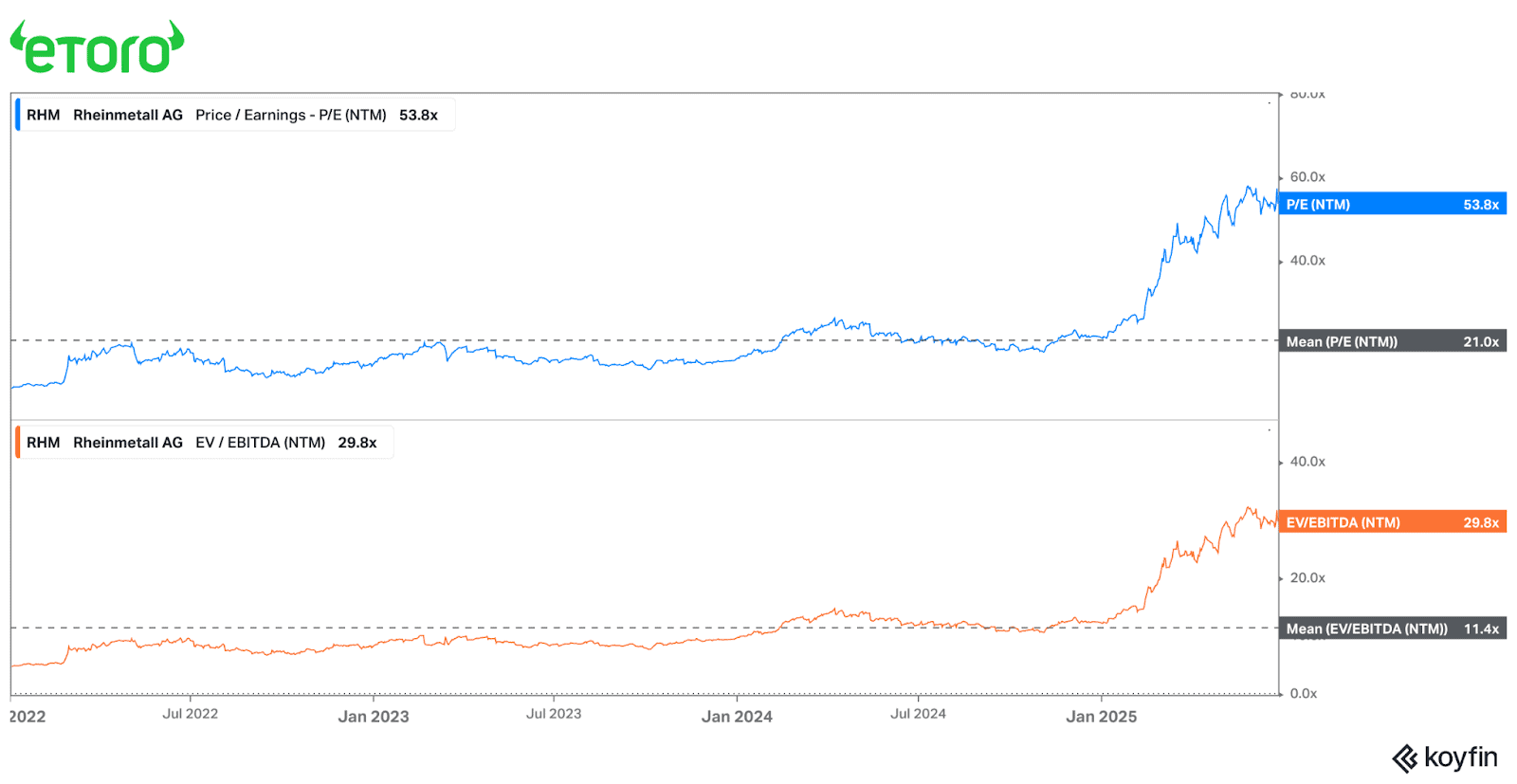
That said, you would have a hard time looking for a clearer growth story than Rheinmetall at this moment. It’s no surprise that 16 Wall Street analysts rate the stock a “Buy,” with just three recommending to “Hold.”
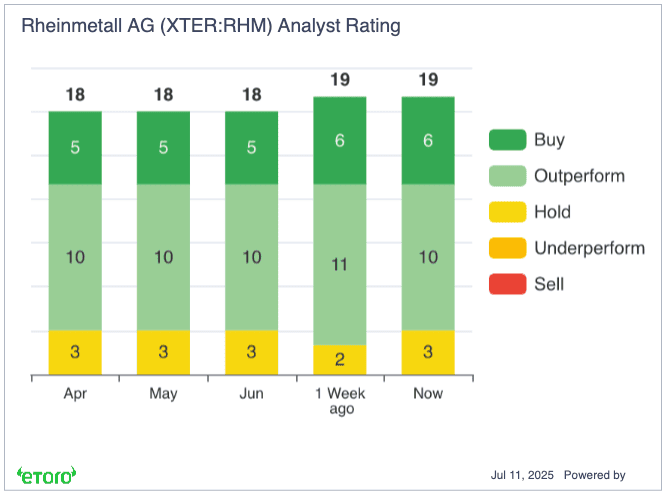
But the optimistic valuation leaves little room for error, as the stock is trading above its 12-month target price. To justify further upside, investors would need to see new catalysts—either a significant jump in margins or a faster ramp-up in production capacity.
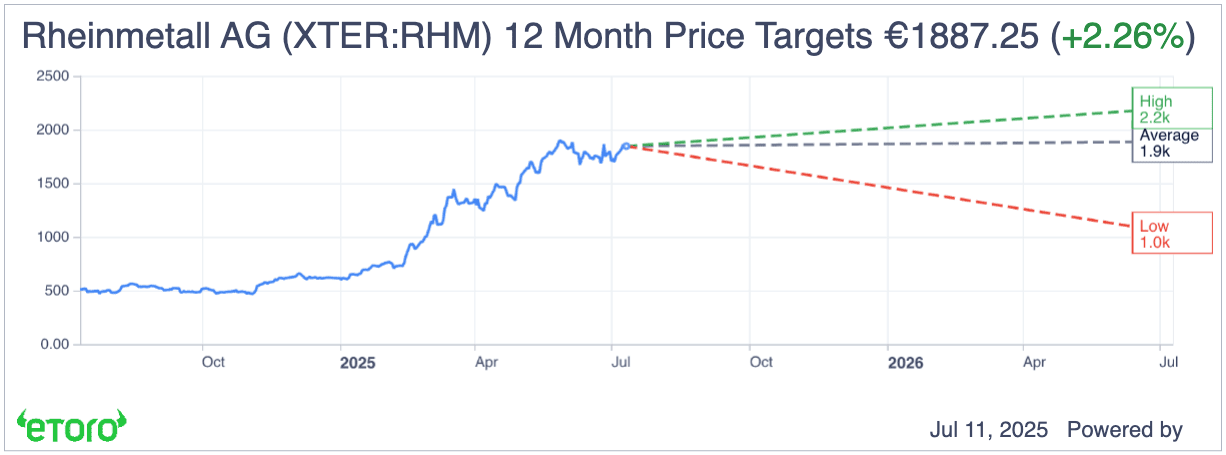
Insider Trading

Source: alphaspread.com
As we can see, insiders, including CEO Armin Papperger, have been actively buying Rheinmetall shares, often taking advantage of short-term dips. That’s typically a bullish signal. After all, while insiders may sell for any number of personal reasons, they usually buy for just one: they believe the stock will go up.
However, it’s worth noting that overall selling volume still outweighs buying, suggesting a more cautious picture.
Upcoming catalysts
Rheinmetall’s upcoming earnings could offer fresh catalysts—such as updates on joint ventures or new expansion projects. While additional demand news is always welcome, the company already has six years’ worth of sales in its backlog, so the more important part is capacity expansion and how fast the business can deliver in booked business.
Key areas to watch in management’s commentary:
- Margin trends – Is there room for further improvement?
- Production volumes – Can capacity scale fast enough to meet demand?
- Pricing power – Is the company able to maintain or improve pricing?
- Segment mix – Are high-margin divisions (like munitions and vehicles) gaining share?
Bull vs Bear case
| View | Key points | Upside / Downside |
| Bull case | If the higher defense spending budgets come through without much political opposition and Rheinmetall is able to capture a large share, we can expect margin growth to continue, capacity expansion to be justified by higher demand and contribute to growth. The key here will be order growth and Rheinmetall’s ability to translate that growth into revenue. The whole bullish thesis rests on the assumption that geopolitical tensions remain unchanged or escalate, which is not an ideal situation. | If nothing materially changes, at the current elevated multiples, the stock is unlikely to grow much more than its earnings growth, which is high at 25%. |
| Bear case | There are many things that could go wrong with Rheinmetall. Geopolitical tensions shift continuously, capacity expansion might get delayed, orders may not translate to revenue as fast as expected or more competition could arise. If the growth story shows any cracks, expect multiple compression. | A reversal to the already elevated 3-year average P/E could mean more than 50% downside. |
Bottom-line Wrap
To sum it up, Rheinmetall has been a powerhouse in the European defense space in recent years. That said, much of the anticipated growth already seems priced into the stock. In my view, the downside risks overshadow upside potential.
For growth-focused investors, Rheinmetall remains a strong compounder with solid momentum—assuming the geopolitical backdrop holds steady. But for value-oriented investors, the train may have left the station some time ago.
What do you think about Rheinmetall? Do you own the stock? Tag me using “@thedividendfund” on eToro and let me know!
This communication is for information and education purposes only and should not be taken as investment advice, a personal recommendation, or an offer of, or solicitation to buy or sell, any financial instruments. This material has been prepared without taking into account any particular recipient’s investment objectives or financial situation and has not been prepared in accordance with the legal and regulatory requirements to promote independent research. Any references to past or future performance of a financial instrument, index or a packaged investment product are not, and should not be taken as, a reliable indicator of future results. eToro makes no representation and assumes no liability as to the accuracy or completeness of the content of this publication.

